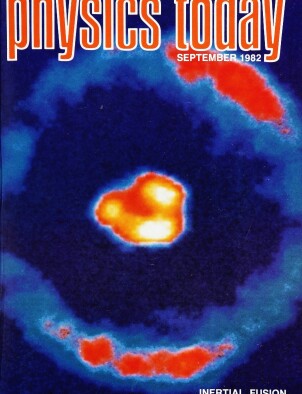Harold Urey and the discovery of deuterium
DOI: 10.1063/1.2915259
It was on Thanksgiving day in 1931 that Harold Clayton Urey found definitive evidence of a heavy isotope of hydrogen. Urey’s discovery of deuterium is a story of the fruitful use of primitive nuclear and thermodynamic models. But it is also a story of missed opportunity and errors—errors that are particularly interesting because of the crucial positive role that some of them played in the discovery. A look at the nature of the theoretical and experimental work that led to the detection of hydrogen of mass 2 reveals much about the way physics and chemistry were done half a century ago.
This article is only available in PDF format
References
1. The thirty‐third annual meeting of the American Physical Society at Tulane University, 29–30 December 1931. Abstracts of papers presented: Phys. Rev. 39, 854. Urey, Brickwedde and Murphy abstract ♯34.
2. H. C. Urey, F. G. Brickwedde, G. M. Murphy, Phys. Rev. 39, 164 (1932).
3. H. C. Urey, F. G. Brickwedde, G. M. Murphy, Phys. Rev. 40, 1 (April 1932).
4. For an interesting account of the discovery of deuterium, see G. M. Murphy, “The discovery of deuterium,” in Isotopic and Cosmic Chemistry, H. Craig, S. L. Miller, G. J. Wasserburg, eds., North‐Holland, Amsterdam (1964). (Dedicated to Urey on his seventieth birthday.)
5. A. B. Lamb, R. E. Lee, J. Am. Chem. Soc. 35, part 2, 1666 (1913).
6. W. F. Giauque, H. L. Johnston, J. Am. Chem. Soc. 51, 1436, 3528 (1929).
7. R. T. Birge, D. H. Menzel, Phys. Rev. 37, 1669 (1931).
8. E. W. Washburn, H. C. Urey, Proc. Nat. Acad. Sci. US 18, 496 (1932).
9. F. W. Aston, Nature 135, 541 (1935);
F. W. Aston, Science 82, 235 (1935).https://doi.org/SCIEAS10. H. Urey in Nobel Lectures in Chemistry, 1922–1941, published for the Nobel Foundation by Elsevier, Amsterdam (1966).
11. Industrial and Engineering Chemistry, News Edition 12, 11 (1934).
More about the Authors
Ferdinand G. Brickwedde. Pennsylvania State University, University Park, Pennsylvania.
